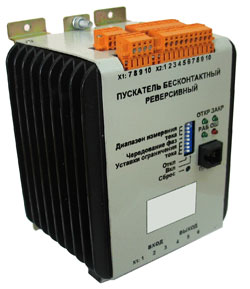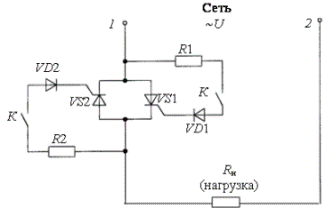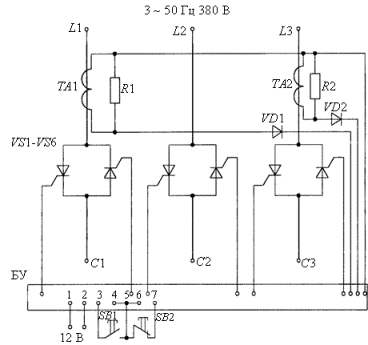Contactless thyristor contactors and starters
Current switching in the circuit of electromagnetic starters, contactors, relays, manual control devices (knife switches, packet switches, switches, buttons, etc.) is carried out by changing the electrical resistance of the switching body within wide limits. In contact devices, such an organ is the contact gap. Its resistance with closed contacts is very low, with open contacts it can be very high. In the switching mode of the circuit, there is a very fast abrupt change in the resistance between the contact gap from the minimum to the maximum limit values (off) or vice versa (on).
Contactless electrical devices are called devices designed to turn on and off (switch) electrical circuits without physically breaking the circuit itself. The basis for the construction of non-contact devices are various elements with non-linear electrical resistance, the value of which varies in a fairly wide range, currently these are thyristors and transistors, used for magnetic amplifiers.
Advantages and disadvantages of contactless devices compared to conventional starters and contactors
Compared to contact devices, contactless ones have the following advantages:
— is not formed electric arcwhich has a destructive effect on the details of the apparatus; response times can reach small values, therefore allowing a high frequency of operations (hundreds of thousands of operations per hour),
— do not wear out mechanically,
At the same time, contactless devices also have disadvantages:
— they do not provide galvanic isolation in the circuit and do not create a visible break in it, which is important from the point of view of engineering safety;
— the switching depth is several orders of magnitude smaller than the contact devices,
— dimensions, weight and price for comparable technical parameters are higher.
Contactless devices based on semiconductor elements are very sensitive to overvoltages and overcurrents. The higher the rated current of the cell, the lower the reverse voltage that the cell can withstand in the non-conducting state. For cells designed for currents of hundreds of amperes, this voltage is measured in several hundred volts.
The possibilities of contact devices in this regard are unlimited: the air gap between the contacts 1 cm long can withstand a voltage of up to 30,000 V. Semiconductor elements allow only a short-term overload current: within tenths of a second, a current of about ten times the rated current. The contact devices are capable of withstanding a hundredfold current overload for the specified time periods.
The voltage drop across a semiconductor element in the conducting state at rated current is approximately 50 times greater than that of conventional contacts. This determines the large heat losses in the semiconductor element in continuous current mode and the need for special cooling devices.
All this suggests that the question of choosing a contact or non-contact device is determined by the given operating conditions. At small switched currents and low voltage, the use of non-contact devices may be more appropriate than contact devices.
Non-contact devices cannot be replaced by contact devices under conditions of high operating frequency and high response speed.

Of course, contactless devices, even at high currents, are preferable when it is required to provide a boost mode of circuit control. But at present, contact devices have certain advantages over non-contact ones, if at relatively high currents and voltages it is necessary to provide a switching mode, that is, simple switching off and on circuits with current at a low frequency of operation of the device.
A significant disadvantage of electromagnetic equipment elements that switch electrical circuits is the low reliability of the contacts. Switching large current values is associated with the appearance of an electric arc between the contacts at the moment of opening, which causes them to heat up, melt and, as a result, damage the device.
In installations with frequent switching on and off of power circuits, the unreliable operation of the contacts of the switching devices adversely affects the operability and performance of the entire installation. Contactless electrical switching devices are devoid of these disadvantages.
Thyristor unipolar contactor
To turn on the contactor and supply voltage to the load, contacts K must be closed in the control circuit of thyristors VS1 and VS2. If at this moment there is a positive potential on terminal 1 (positive half-wave of an alternating current sine wave), then a positive voltage will be applied to the control electrode of the thyristor VS1 through the resistor R1 and the diode VD1. The thyristor VS1 will open and the current will flow through the load Rn. When the polarity of the mains voltage is reversed, thyristor VS2 will open, thus connecting the load to the AC mains. When disconnecting from contacts K, the circuits of the control electrodes are opened, the thyristors are closed and the load is disconnected from the network.

Electrical diagram of a single-pole contactor
Contactless thyristor starters
Three-pole thyristor starters of the PT series are developed for switching on, off, reversing in the control circuits of asynchronous electric motors. The three-pole starter in the circuit has six thyristors VS1, …, VS6 connected to two thyristors for each pole. The starter is switched on using the control buttons SB1 «Start» and SB2 «Stop».
Contactless three-pole thyristor starter of the PT series

The thyristor starter circuit provides protection of the electric motor from overload, for this, current transformers TA1 and TA2 are installed in the power section of the circuit, the secondary windings of which are included in the thyristor control unit.
